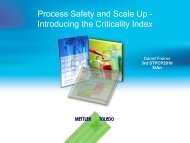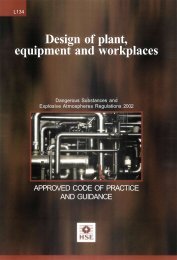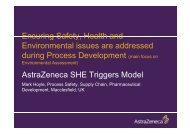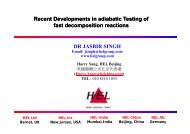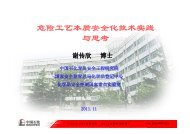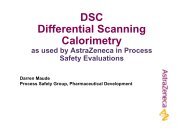Designing and operating safe chemical reaction processes HSG143
Designing and operating safe chemical reaction processes HSG143
Designing and operating safe chemical reaction processes HSG143
Create successful ePaper yourself
Turn your PDF publications into a flip-book with our unique Google optimized e-Paper software.
Health <strong>and</strong> SafetyExecutive176 The technical documentation may also contain many other pieces ofinformation, eg quality specifications, yields, <strong>safe</strong>ty data sheets, environmentalassessments, etc.177 The technical documentation is the history of the design process. The intent<strong>and</strong> reasoning for the process should therefore be clear to someone new to theparticular process.Safe <strong>operating</strong> instructions178 The <strong>safe</strong> <strong>operating</strong> instructions are for use by the plant operators. They needto be clear, simple <strong>and</strong> unambiguous. They should contain:(a) the substances used in the process, their hazards <strong>and</strong> the precautions to betaken, eg the personal protective equipment (PPE) that must be used;(b) any critical <strong>safe</strong>ty systems on the plant <strong>and</strong> the action to be taken when theyoperate - relate this to the <strong>safe</strong> <strong>operating</strong> envelope <strong>and</strong> the basis of <strong>safe</strong>ty;(c) a step-by-step procedure to carry out the process; <strong>and</strong>(d) emergency procedures.179 It is a requirement of PSSR 5 that any person <strong>operating</strong> a pressure system isprovided with adequate <strong>and</strong> suitable <strong>operating</strong> instructions.180 Make the <strong>safe</strong> <strong>operating</strong> procedures easier to underst<strong>and</strong> by stating thecritical action points. For example, if you require an operator to control the reactorcontents temperature, state in the instructions that the temperature should notexceed, say, 100 o C <strong>and</strong> that activation of the emergency reactor cooling shouldoccur at 90 o C <strong>and</strong> that the reactor should be shutdown at 95 o C.181 You can give operators guidance on the magnitude of a specified action toachieve a specified goal. For example, rather than letting the operator guess howmuch to open a valve, suggest opening to a certain amount, then using minoradjustments to get the desired start-up flow. Give guidance on how to lead or lagin changing setpoints; or advise on how long to blow a line to clear it of liquid. Takeout the guesswork.Process changes <strong>and</strong> modifications182 It is important that you do not modify the <strong>chemical</strong> <strong>reaction</strong> process systemuntil you have considered the <strong>safe</strong>ty implications. You need a formal managementsystem developed for modifications to plant, procedures <strong>and</strong>/or process chemistry.183 Changes considered as minor can lead to hazardous conditions developing.For example, a change of catalyst can lead to a significant increase or decreasein the rate of <strong>reaction</strong>. Decreases in rate can cause accumulation of reactants.Changing the form of a reactant from a pellet to a powder can significantly increasethe <strong>reaction</strong> rate.A violent decomposition occurred when a <strong>reaction</strong> normally carried out in astainless steel reactor was changed to a mild steel one. Traces of iron that haddissolved in the <strong>reaction</strong> mass catalysed the decomposition.<strong>Designing</strong> <strong>and</strong> <strong>operating</strong> <strong>safe</strong> <strong>chemical</strong> <strong>reaction</strong> <strong>processes</strong> Page 34 of 64





